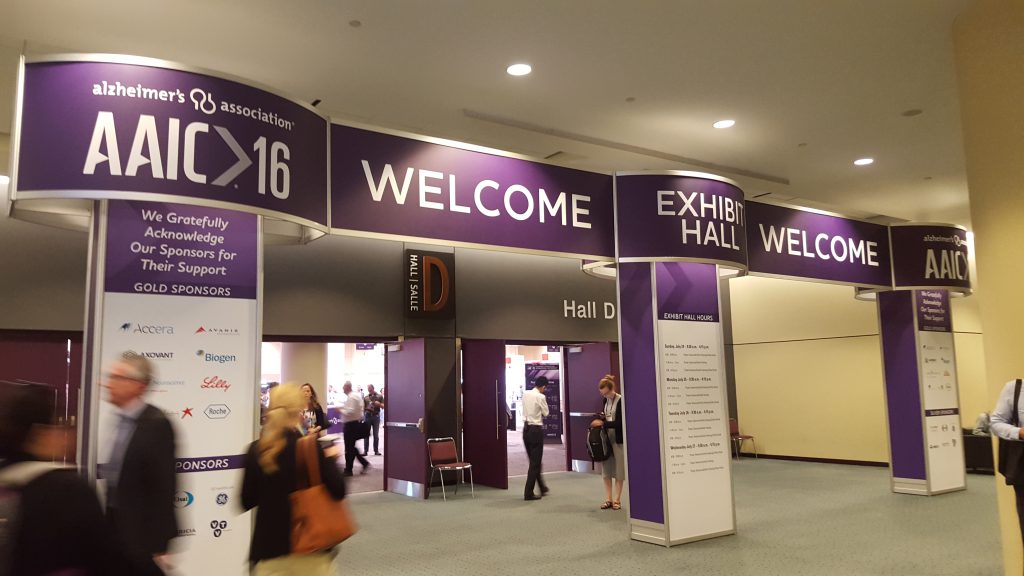Last week, the Xtalks Blog covered some of the most exciting research presented at this year’s Alzheimer’s Association International Conference (AAIC). In order to find out what those in the industry are doing to advance Alzheimer’s disease diagnosis, disease management and treatment options, I spoke to some of the veterans and the newcomers in the space. What they had to say highlighted the challenges facing pharmaceutical companies and clinical trials companies working on Alzheimer’s disease today, as well as the strategies in use to try to mitigate some of those problems.
What tools can be used to diagnose early-stage Alzheimer’s disease?
Dr. Karthik Kuppusamy, Vice President & General Manager, Neurology Solutions, Quest Diagnostics – “There has been a challenge in terms of the ability of primary care physicians to actually identify patients that have cognitive impairment at a very early stage. At this conference, we are actually launching a new iPad-based assessment called CogniSense, which has been validated on 3,500 patients.
“This is primarily targeted towards primary care physicians for use as an objective tool to understand patients with cognitive impairment. We have utilized this tool over the last 12 months with an ACO [accountable care organization] called Primary Partner Care in New York City.
“They have done it on more than 656 patients so far, and within their patient community they were initially able to identify only 17 percent of people with cognitive impairment. After using the tool, the same primary care physicians are able to identify more than 40 percent of patients with cognitive impairment.
“One in every ten patients over the age of 65 have some form of dementia, and it rapidly advances to one in two over the age of 85. It’s important that our primary care physicians are able to identify the onset of impairment within the patient community that they serve.”
To learn more about Quest Diagnostics, register for their recent webinar on oncology drug development and the role of biomarkers.
Dr. Marco Cecchi, Director, Research and Clinical Affairs, Neuronetrix – “COGNISION™ is an integrated system for electroencephalography, and it is specifically designed to test cognitive function. It’s FDA approved in the US, and the test was recommended in the original diagnostic criteria for Alzheimer’s of 1984.
“The original problem was implementation, as it was very hard to do this kind of testing outside research labs. You needed a shielded room and an EEG [electroencephalogram] technician that would analyze the data by hand. What the company set out to do was to make these kind of tests practical in any kind of environment. Now with this system it is possible to run this test without a shielded room in out-patient settings and you don’t need an EEG technician, so anybody can run the test and the results are immediately available by the click of a button.”
How can Alzheimer’s disease be better managed?
Dr. Ben Newton, Director of PET Neurology, Life Sciences, GE Healthcare – “GE Healthcare designs and develops tracers for use in PET-CT [positron emission tomography–computed tomography] and PET-MR [positron emission tomography–magnetic resonance]. Vizamyl is a PET amyloid tracer designed to detect amyloidosis in the brains of patients with dementia, in order to aid early diagnosis, differentiation or stratification in those patients.
“In addition to that, we have software that allows for the quantification of tracer uptake into the brains of patients with cognitive disorders and neurodegenerative disorders. That software gives a precise measure of pathology in the brain, and also co-registers that information with MR.
“So what that allows you to do, is to identify where the pathology is, what kind of pathology it is, whether it’s tau or amyloid using the tracers, and what’s happening with respect to the brain structure in those areas. Now that’s really important if you want to figure out what’s happening to the patient in terms of the speed of their progression to Alzheimer’s, or their risk of converting from mild cognitive impairment through to Alzheimer’s disease.”
Are there any new treatment strategies for Alzheimer’s disease and cognitive impairment?
Lew Lim, Founder & CEO VieLight – “In a small randomized control study of [the VieLight] including 19 patients, we found people with moderate to severe Alzheimer’s actually showed a significant improvement. I think we are just about the only modality that has shown an arrest, or even reversal, of Alzheimer’s disease in a human study. We are in the process of designing a study for much bigger population, and one that’s aimed for regulatory approval as well.
“The premise [of the VieLight] is that neurons respond to red and infrared light. There are mitochondria in the neurons just like all cells, and they convert that light into increased synthesize of ATP, which is cellular energy. That leads to transcription and then into cellular repair restoration.”
How are companies supporting the development of new Alzheimer’s therapies?
Dr. Marco Cecchi, Director, Research and Clinical Affairs, Neuronetrix – “Just like we can measure cognitive impairment [using COGNISION™], we can measure the effect of procognitive compounds on people with Alzheimer’s or with dementia. We are working with pharma where they are using this device to look at target engagement to ensure the drug crosses the blood-brain barrier and hits the target. It is also used to optimize the dose in clinical trials so that they can go into a later trial with the best likelihood of success.
What are some challenges of conducting Alzheimer’s clinical trials?
Stephen Coates, Executive Director, Franchise Leader, Alzheimer’s Disease and Other Dementias, Worldwide Clinical Trials – “Compared to ten years ago, there’s so many more trials and there’s so much more competition across the sites, but ultimately you are still looking at a disease that has an endpoint that is determined by a person and a cognitive scale. You have a study that goes on for three or four years, and you get raters who leave a site. During a patient’s journey through a study, they could have two or three raters, so their baseline becomes less relevant when you have a completely different person assessing them from the beginning.
“It’s tricky and because of the patient population as well. An Alzheimer’s patient will feel much better one day than they did a couple of days ago, and if you get them in a clinic visit on a particularly rough day, then that’s going to be reflected in the scale. They could wake up the next morning feeling better and do 15 percent better on that scale. There’s a lot of variability in the patient population. It’s not like a cardio study where you can measure [hemoglobin] A1c, so it’s difficult and it’s always going to be difficult.”
Dr. Todd Solomon, Senior Clinical Scientist, Bracket Global – “I think the pattern has been – and we’ve seen it time and time again – you see someone at AAIC who relates fantastic phase II data. I think what companies are learning, and they’re learning it the hard way, is that you do a study with 150 patients in one country with 50 sites, and that’s a much different beast than going into that pivotal phase III where you need 1000 patients and 30 countries.
“This becomes even more difficult when you start thinking about standardizing these things across languages and patient populations in various countries and different raters. That’s where I think we’ve brought a lot of value because we work across countries.”
Register for Bracket’s webinar on data analytics to gain more insight into CNS clinical trials.
How can sponsors enroll the right patients into Alzheimer’s clinical trials?
Anna Jackson, Healthcare Business Manager, Cambridge Cognition – “We’ve just released CANTAB Recruit, and it’s going to enable mass screening for Alzheimer’s trials because it’s a web-based tool. This is based on an episodic memory test; the CANTAB Paired Associates Learning task. So we’ll be able to help pharmaceutical and biotech trials by finding the right people early on and reducing costs, because this is the new gold standard for finding people with a mild cognitive impairment.” *
To learn more about assessing cognitive function in clinical trials, register for Cambridge Cognition’s recent webinar.
Dr. Ben Newton, Director of PET Neurology, Life Sciences, GE Healthcare – “One of the challenges in Alzheimer’s disease is the lack of drug treatments. There are some really effective symptomatic treatments available, but very few – if any at all – are truly disease-modifying drugs.
“There is a lot of emphasis at this congress on new types of drugs that inhibit the development of amyloid, or remove amyloid through antibody approaches. We’re supporting many of those clinical trials and the way we’re doing that is to identify patients with amyloid using Vizamyl as a tracer to detect amyloid. If they have amyloid, then they are included in the clinical trials, either in the placebo arm or a drug treatment arm. The aim is after one to three years of treatment, to show that the amount of amyloid is either stabilized or not increased anymore, or even decreased, and the cognition of those patients on the drug treatment is improved or stabilized over that time.”
Dr. Marco Cecchi, Director, Research and Clinical Affairs, Neuronetrix – “The other use [for COGNISION™] in clinical trials is to try to screen people for a very early stage clinical trial. It’s very hard to know which people have dementia or Alzheimer’s very early in the disease, and so what happens with these big trials companies is that they screen a lot of people and most of them end up being failures. That is a big cost for the company. A device like this could be an additional data point that could help them actually discriminate people that have dementia and that could be good candidates for the clinical trials.”
What are some current clinical trials being conducted in the Alzheimer’s space?
Dr. Ben Newton, Director of PET Neurology, Life Sciences, GE Healthcare – We’re participating in the IDEAS [Imaging Dementia – Evidence for Amyloid Scanning] trial which is designed to show a clinical utility change resulting from PET amyloid scanning. If we get the IDEAS trial right and get approval [for Vizamyl] in Canada, we’ll have the diagnostic capabilities to understand the disease and to diagnose early. If we’re successful on the drug side, we’ll have the means to treat patients to improve the quality of life and hopefully bring about an end to the dementia crises.”
What is the translation value of animal models of Alzheimer’s disease?
Dr. Robert Smith, Associate Director, Rater Training, inVentiv Health – “I’ve been doing this job for 30 years. As a clinician, I’ve worked on 100 studies and only five [drugs] made it to the marketplace. That hasn’t changed a lot, so you start to say something’s wrong. Is it the methodology? Is it the drugs? Is it the animal models? Is it a combination of all of those things? I think we are starting to be more critical but I don’t think there’s one answer.”
To learn more about assessing cognitive safety of drugs in clinical development, register for inventive Health’s recent webinar.
Dr. Afshin Ghavami, VP, Research Operations, PsychoGenics – “Sometimes companies are not looking at the right thing but they call the drug efficacious, so maybe that’s why they fail when they get into the clinic. I can tell you, I worked in Big Pharma myself and we did a lot of Alzheimer’s research. All of the compounds we looked at were in one rat model and that was the screening. So if your decision is based on [one model] only, obviously your compound is going to fail.”
What are some changes in the way we think about Alzheimer’s pathology?
Dr. Peggy Taylor, General Manager, Neuroscience, BioLegend – “I would say that on the basic research side, there’s been a lot of discussion about protein misfolding and propagation of aggregates in the brain and how they travel across neural networks. There’s been new biomarkers emerging, especially those related to synaptic integrity, to support the gold standards of beta amyloid and tau. I think that the field of neurodegeneration is really coalescing and there’s cohorts of clinical samples available, imaging data, cerebrospinal fluid biomarkers, blood biomarkers to help people really start to understand the mechanisms of disease.”
What is the outlook for Alzheimer’s disease in the future?
Stephen Coates, Executive Director, Franchise Leader, Alzheimer’s Disease and Other Dementias, Worldwide Clinical Trials – “I think it’s looking a lot more positive than it ever was. I think the “holy grail” is going to be a diagnostic test where everyone who hits 50 years old will have a blood test taken and you’ll see whether they’re susceptible or not. Then they would be put on a drug as a preventative. Whether you can ever find something that reverses the process, I don’t know, it would be wonderful if you could.”
The overall theme of this year’s AAIC was cautious optimism. While some people were encouraged by the advances being made in our understanding of the pathology of the disease, viable treatment options for Alzheimer’s disease remain elusive. With a resurgence in research and funding into Alzheimer’s and other dementias, those working in the space have their best chance to-date to make an impact on the lives of patients.
*Updated August 16, 2016 – Quote was updated to improve readability.
Did you attend this year’s AAIC 2016? What do you think contributes to the difficulties facing researchers and clinicians in the Alzheimer’s space today? Share your opinion in the comments section below!












Join or login to leave a comment
JOIN LOGIN